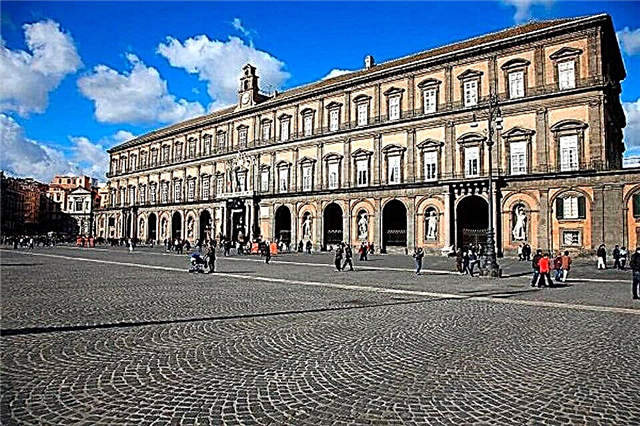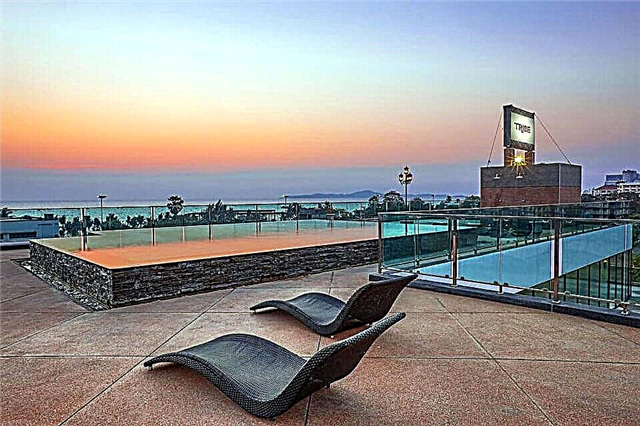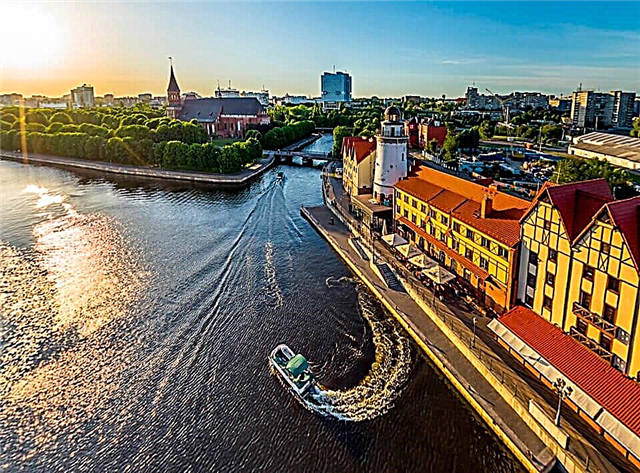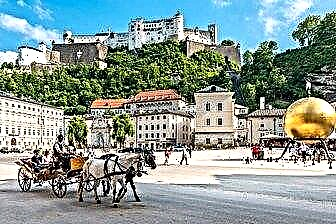The charming Salzburg lies in the Salzach valley amid the picturesque Alps. The hills within the city offer breathtaking views of the mountain range - covered with silvery snow in winter and emerald green in summer.
Salzburg is the birthplace of the incomparable Mozart, the birthplace of his musical genius. The city has a large number of concert halls and temples where classical music is played. In summer, Salzburg hosts the iconic Opera Festival, which attracts the best performers from all over the world.
The streets of Salzburg are mixed with medieval and Baroque architecture, which gives the city a unique and enchanting look. The austere Romanesque appearance of the Hohensalzburg Fortress is diluted with the symmetrical lines of classical cathedrals and Baroque mansions, and the narrow stone streets contrast with the wide green lawns of the palace landscape parks.

The best hotels and hotels at affordable prices.
from 500 rubles / day
What to see and where to go in Salzburg?
The most interesting and beautiful places for walking. Photos and a short description.
Residenceplatz
Salzburg's main square, located in the old part of the city. The architectural ensemble of the area was formed by the 17th century. Around the square is the residence of the archbishop, the cathedral, burgher mansions of the 16th-17th centuries. The centerpiece is a magnificent baroque fountain. It was built by order of Guidobald von Thun, Archbishop of Salzburg in the 1660s. Skilled Italian craftsmen worked on the sculptures.

Capitalplatz
A wide square in the old part of Salzburg, located right under the walls of the city fortress. The baroque buildings nearby are the residences of the higher clergy. The most attractive composition for tourists is the modern monument to Paul Fürst. This pastry chef invented the famous Mozartkugel sweets. The structure is made in the form of a golden ball on a stand, crowned with a human figure.

Hohensalzburg Fortress
11th century Romanesque castle, built under Archbishop Gebhard. The severe bulk of the fortress rises above the city and is its architectural dominant. Over the past centuries, the castle was completed and fortified many times, gradually turning it into an almost impregnable bastion. For nine centuries, Hohensalzburg has stood against the backdrop of the picturesque Alps, during which time it withstood several sieges, managed to serve as a barracks and a gloomy prison.

Mirabell Palace and Gardens
The palace and park complex was erected at the beginning of the 17th century and rebuilt in a Baroque manner in 1727. After the fire of 1818, it was practically rebuilt, based on the calm neoclassical style. "Mirabelle" in translation from Italian means "beautiful". The palace was erected for the secret wife of Archbishop von Raithenau, after his deposition until the 19th century, other Salzburg archbishops lived here. Later, the complex was handed over to the city authorities.

Helbrunn Palace
The elegant Helbrunn is 6 kilometer away. from Salzburg. It was erected at the beginning of the 17th century for Archbishop M. Zittikus according to the design of the architect S. Solari. A Mannerist park is laid out in front of the palace, decorated with figures of stone monsters, fountains, secret grottoes and artificial ponds. The interior decoration of Helbrunn is quite luxurious, especially the main hall and the music lounge.

Leopoldskron Palace
The palace is located in the southern part of Salzburg. It was erected for Archbishop Leopold Firmian in the 18th century. The architectural project was developed by a monk of the Order of St. Benedict, who was also a talented architect. Leopoldskron was intended for the residence of the archbishop and his family. The interior decoration of the palace is dominated by a slightly pretentious Rococo style with rich murals.

Klessheim palace
The former archbishop's residence, which in the 20th century was actively used by Hitler to organize official receptions. Many political figures have been here, including the closest ally of the Fuhrer B. Mussolini. Nowadays, there is a casino on the territory. The palace complex is surrounded by a picturesque classic English-style park and golf courses. On the territory of the palace there is a restaurant of exquisite European cuisine.

Salzburg Cathedral
Salzburg Cathedral, one of the most notable and picturesque sights of the city. This temple houses the baptismal font in which the great Wolfgang Amadeus Mozart was baptized. The majestic facade of the building is made in the architectural style of the early Baroque. The building of the cathedral is included in the UNESCO World Heritage List. The very first church in its place appeared in the 8th century, until the 17th century the cathedral experienced several fires and destruction, after which it was demolished and completely rebuilt.

Collegienkirche
The main chapel at the University of Salzburg, located in the heart of the city. The temple was built in the period 1694-1707. designed by I. von Erlach. This master also worked on the architectural plans of the Karlskrihe Church and Schönbrunn Palace located in Vienna. The collegiatekirche is made in the style of the "Habsburg Baroque", the main facade is decorated with ornamental stucco molding in the late Rococo style.

Franciscan Church
One of the oldest temples in Salzburg, built in the distant VIII century. The church has been rebuilt many times, which is why its appearance has absorbed several architectural styles. Thanks to this fact, the Franciscan church looks unusual and quite interesting. In the 18th-19th centuries, the interior of the building acquired dominant baroque features, and a major restoration of the facade was also carried out.

Nonnberg abbey
The history of Salzburg began with Nonnberg Abbey. The monastery was founded by Saint Rupert in the 8th century, and from that time it functioned as a convent for noble representatives of aristocratic families (only from the 19th century ordinary girls began to be admitted here). Thanks to the generous donations of wealthy sisters, the abbey amassed an impressive fortune and began to enjoy serious influence in the surrounding lands.

Abbey of st peter
Active male monastery, founded by the patron saint of Salzburg, Saint Rupert in the 7th century. Unlike Nonnberg Abbey, some parts of the cloister are open to the public. Over the centuries, the complex was rebuilt many times, now its architecture is dominated by the graceful Baroque style. The relics of St. Rupert are buried in the monastery church of St. Peter, as well as the crypt of the sister of V.A. Mozart - Anna Maria Mozart.

St. Peter's cemetery
The cemetery is located next to St. Peter's Abbey in the historic center of Salzburg. This place has long become a unique and invaluable historical heritage of the city and is included in the list of the most popular attractions. The remains of many famous townspeople are buried here. The first graves, according to research, appeared in the first centuries of our era. Now in the cemetery you can find the surviving burials of the 12th century.

Archbishop's residence
On the main city square there are two residences of the Archbishop - Old and New. The old building was erected at the beginning of the 12th century and was rebuilt many times. In the 15th century, the residence was rebuilt under Dietrich von Reitenau. Now it houses an art gallery. The building of the New Residence was erected at the beginning of the 17th century; today it is given over to the Sattler City Museum.

Mozart's birthplace
House located at the address: Getreidegasse, number 9. Here in the period 1747 - 1773.the family of the great musician lived. A future genius was born in this house. The museum was created in 1880 with the support of the International Mozart Foundation. The museum exposition consists of various items belonging to the family and personally to Wolfgang Amadeus. Among the exhibits are a musician's children's violin and harpsichord, letters, portraits, scores.

House of Mozart
House on Marktplatz, where Mozart and his family lived in one of the apartments until 1780. Within the walls of this apartment, many immortal works of the brilliant musician were created. In 1944, the building was destroyed by a bomb, so nothing remained of the old interior. The house was restored in the 90s. XX century funded by the International Mozart Foundation. A small collection consists of the maestro's personal belongings, musical instruments and interior items.

House of nature
A popular entertainment center and museum especially loved by children. The exhibition is located in two buildings on eight floors, includes more than 30 halls and a full-fledged scientific center. In the House of Nature you can learn a lot about the fauna and flora of Austria and other countries of the world, get a lot of useful historical information, take a trip through the human body and look at prehistoric dinosaurs.

Salzburg Landesteater
The history of the theater began in the second half of the 18th century with the production of "The Grace of Princes" by the author K. Schmidt. Schiller's early plays were often staged on the stage. Throughout its existence, the theater has changed its name more than once. The old building was demolished in 1892. The modern building appeared in the 1940s. XX century. Today, the Landesteater is the main theater stage in the Federal State of Salzburg.

Mozarteum
The conservatory and concert hall named after V.A. Mozart. Mozerteum was founded in 1870 as an international foundation to help talented young musicians. Ten years later, a music school was opened on its basis. In 1924 Mozerteum received the status of a conservatory. Here students learn to play a variety of instruments, conductor's profession, music theory and musical creation.

Puppet theater
The Salzburg Puppet Theater has existed since 1913 and is considered the oldest in Europe. For more than 100 years of work, it has gained worldwide popularity. Both children and adults go to the theater performances with pleasure. The central place in the repertoire is occupied by works performed with the accompaniment of music by V.A. Operas, ballets, dramatic plays, operettas are performed with the participation of puppets.

Getreidegasse street
A picturesque street in the old town, which has long been considered the center of Salzburg's trade. To this day, it houses the city's best (and most expensive) shops with quirky signage and almost museum-like interiors. Getreidegasse houses boutiques of world brands and local shops, which are already a couple of hundred years old. The street starts at the Residenzplatz and crosses the entire old part of Salzburg.

Hangar-7 Red Bull
A modern and rather unusual museum, created on the basis of the collection of aircraft of the founder of the energy drink "Red Bull". The museum is located on the territory of Salzburg Airport. There are many rare items in Hangar-7: sports aircraft models, light recreational aircraft and much more. The museum has a restaurant with excellent author's cuisine.

Europark
An imposing shopping center with over 100 stores. Here you can find both expensive designer items and products at more democratic and affordable prices. There are cafes on the territory of the shopping center, various entertainment events for adults and children are organized, concerts are held. The Europark shopping center is a major leisure center for families in Salzburg.

Kapuzinerberg
In past centuries, the Kapuzinberg hill was part of the Salzburg fortification system, but in 1594 a monastery was built on its top at the behest of Archbishop W. Dietrich von Raithenau. Now the mountain is used as a place for walks and relaxation in the bosom of nature. Convenient hiking trails are laid along the gentle slopes. From the top of the Kapuzinberg, a picturesque view of Salzburg, the surrounding valleys and the spurs of the Alps opens up.

Salzburg Zoo
Like any good European zoo, the Salzburg Zoo supports the concept of a natural habitat for animals. They try to keep the animals in conditions close to natural ones. The territory of the zoo is divided into zones: "savannah", "steppe", "mountains", "forest" and others. Each animal is kept in a corresponding "natural zone", which creates the most comfortable conditions for the health and life of the zoo's inhabitants.












